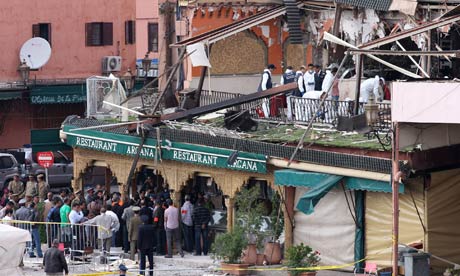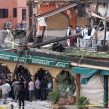
Al-Qaeda in the Islamic Maghreb Attacks Morocco’s “Kingdom of Corruption and Despotism”
Publication: Terrorism Monitor Volume: 11 Issue: 23
By:

Al-Andalus, the media branch of al-Qaeda in the Islamic Maghreb (AQIM), released a rather sophisticated and detailed video on Morocco titled “Le royaume de la corruption et du despotisme" (The kingdom of corruption and despotism) on September 12. [1] The video mixed a series of elements, from Wikileaks cables to TV reports, to present a harsh set of accusations against Moroccan King Muhammad VI (Lakome [Rabat], September 14, 2013; Afriquinfos [Barcelona], September 16). Communications Minister and government spokesman Mustapha al-Khalfi said that the AQIM broadcasting was an “attempt to undermine the Moroccan model” (Maroc.Ma, September 18).
Morocco has been targeted by major terrorist attacks in the past, the most recent being an April 2011 attack in Marrakesh, in which a remote controlled bomb detonated in Jamaa al-Fna square, killing 17 people and injuring 20 more. AQIM denied its involvement in this operation, saying that it was likely carried out by local Moroccan militants with experience in other theaters (Le Figaro, May 7, 2011; Jeune Afrique, May 6, 2011). The two individuals ultimately charged with carrying out the attacks, Adil Athmani and Hakim Dah, were later condemned to death (La Nouvelle Tribune, March 3, 2012).
Morocco’s Groupe Islamique Combattant Marocain (GICM – Moroccan Islamic Combatant Group) was a Sunni Islamist terrorist organization affiliated with al-Qaeda. Its alleged leader, Sa’ad Houssaini, was arrested in 2007 on charges of involvement in the May 2003 attacks that killed 45 people in Casablanca (Aujourd’hui Le Maroc, March 9, 2007). The investigations of these attacks revealed that the organizational link with al-Qaeda central was rather loose, though the group was likely inspired by al-Qaeda. However, the group’s capacity to operate in Morocco remained limited and the group lost its operational capacity after the 2003 government crackdown. Locally, it has been suggested that this group was never a fully organized movement, but more of a label, used by Moroccan security services to describe a loose network of independent militants operating outside and within the country.
Given this history, the AQIM video is particularly notable – it represents AQIM’s first real and open threat against the kingdom (Le Monde, September 18). However, the rationale behind this video likely stretches beyond the specific idea of targeting Morocco in the future. It is more likely that AQIM, which is undergoing a major process of reorganization following the French-led intervention in Mali, wants to send a signal to potential militants in Morocco. This is an attempt to push them to join their ranks and direct their rage against the system (embodied by the king) in an AQIM-guided jihad (L’Observateur du Maroc, February 11; see also Terrorism Monitor Brief, October 18).
In historical terms, the concept of “Grand Maroc,” promoted especially by nationalist circles linked to the Istiqlal Party, was central in the formulation of Moroccan foreign policy in the immediate aftermath of independence. According to this concept, the country’s natural and historical territory includes Mauritania, the western part of northern Mali (including Timbuktu), the Western Sahara and a sizeable part of southern Algeria. Mauritania, especially, has been the target of a series of political, legal and diplomatic strategies implemented by Morocco to extend its sovereignty over it. However, the end of Spanish rule over the Western Sahara in 1975 changed the priorities of Rabat, which helped the two countries improve their bilateral relations, since Morocco understood that improving relations with Mauritania was helpful in maintaining its control over the Western Sahara. Moreover, as the focus of Moroccan foreign policy shifted more clearly toward the Mediterranean (EC/EU) and Atlantic (USA) dimension, Morocco recognized the cost of being perceived as an expansionist nation in the Arab and African world and irredentist claims progressively lost their central place in Morocco’s foreign policy discourse.
An unforeseen result of this change was that Morocco’s lack of a Saharan/Sahelian geopolitical depth has become a security asset for Morocco, helping the country to avoid the direst consequences of the regional destabilization of the past three years. Morocco has been able to contain the revolutionary wave that hit other regional countries in 2011’s Arab Spring. Muhammad VI, aware that granting some reforms would help ease political tensions, decided to make some constitutional changes. However, some of these changes were more cosmetic than effective, as the presence of a shadow cabinet of counselors appointed directly by the King reduced the space for maneuver of the forces that emerged from the elections dominant, especially the Islamist Justice and Development Party (JDP). Moreover, the presence of a strong pro-royal sentiment in Morocco also played a role in reducing the spillover effects of both the Arab Spring and the subsequent destabilization of the Sahel.
From this point of view, while AQIM threats are real, the capacity of the organization to operate in Morocco remains limited. AQIM is in a process of internal and operational reorganization following the disruption of its networks in Northern Mali. While local cells of jihadists tied to al-Qaeda exist in Morocco and infiltration from neighboring countries remains possible given the porous nature of regional borders, their presence cannot be compared to that of groups in other Maghreb countries such as Algeria, Libya and Tunisia.
The threat to Morocco from Sahelian terrorist groups is primarily a governance challenge. The geographical proximity of Europe makes Morocco a major terminal for the drug trafficking smuggling South America via West Africa to Europe that runs across the 10th parallel north (a.k.a. “Highway 10”). This traffic is augmented by the flourishing cultivation of hashish in Morocco, which remains a major problem despite the efforts of authorities to fight it. Finally, while the presence of Saharawi fighters in the ranks of AQIM and other regional terrorist organizations is a reality, Moroccan authorities and media have largely overestimated this presence, which is not by any means as structured and dangerous as Rabat presents it. The Western Sahara issue remains at the core of Moroccan national interests (see Terrorism Monitor, December 2). This centrality explains why Morocco tries to exploit the presence of Saharawi militants in these groups to strengthen the support of external countries for its territorial claims, in a similar fashion to what other regional countries have done, and do, to buy the support of many Western capitals. Despite the presence of significant historical and political links between Morocco and the Sahelian space, this space now occupies only a residual importance in the geopolitical vision of the country. Morocco continues to be largely focused on its Maghrebi, Mediterranean and Atlantic dimensions.
The recent tensions between Morocco and Algeria and the persistence of a zero-sum view of their relationship continue to prevent Rabat and Algiers from greater cooperation in the fight against regional terrorism. For Morocco, the Sahel is a source of potential threat, but it is also a space in which to reduce the capacity of its major regional rival to enjoy a greater freedom of action in the wider North African context.
In terms of threat assessment, the terrorist threat against Morocco is real, but it cannot be compared to that faced by other countries in the region. Morocco has its own local jihadists. In August, the government announced that it had dismantled a cell connected to AQIM operatives in the cities of Fez, Meknes, Taounate and Tiznit (The Daily Star [Beirut], August 16). The flow of drugs and illegal goods that pass through Moroccan territory represents a significant reminder of how porous the Moroccan borders remain, despite the fact that Morocco is one of the most effective sovereign countries, in the region in particular and in Africa in general.
AQIM is undergoing a major process of internal change following years of crackdowns in Algeria, the progressive Sahelization of its geographical focus and the hybridization of its activities, divided between pure jihad and mafia-style criminal activities. The recent video is likely part of a wider AQIM strategy to re-acquire its regional operational depth. For Morocco, regional terrorist groups represent more of a governance challenge, given their role in illegal trafficking, than a direct security threat. However, there is a risk that small cells, either inspired by al-Qaeda or with organizational ties to AQIM, may begin operations in Morocco.
Dario Cristiani is a PhD Candidate in Middle East and Mediterranean Studies at King’s College London. Previously, he has been a teaching fellow in Political Science and Comparative Politics at the University of Naples "L’Orientale" and a political analyst with the Power and Interest News Report (PINR).
Note
1. See: https://twitter.com/Andalus_Media.




